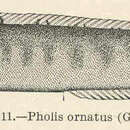pms
nòm ant ël fil


Pholis laeta és una espècie de peix de la família dels fòlids i de l'ordre dels perciformes.[7]
Els adults assoleixen la maduresa sexual en arribar al voltant dels 10 cm de longitud.[9][8] A l'illa de Vancouver, les femelles ponen entre 600 i 1.600 ous a mitjans del gener[9] o del gener al febrer a prop de Victoria (la Colúmbia Britànica, el Canadà).[8] Els ous són demersals, s'adhereixen entre si o al substrat i són custodiats per qualsevol dels pares o deixats sense vigilància. Les larves es desclouen després de dos mesos i són planctòniques.[9]
Probablement es nodreix de crustacis petits i de cucs marins.[13]
És depredat per aus marines[14] (com ara, el bernat americà -Ardea herodias-[15] i el somorgollaire columbí -Cepphus columba-),[16] grans peixos submareals[17] i mamífers (la llúdria del Canadà -Lontra canadensis- i el visó americà -Mustela vison-).[18]
És un peix marí, demersal (fins als 73 m de fondària)[19] i de clima temperat, el qual viu al Pacífic oriental: les zones intermareals[11][20][21] des de les illes del Comandant i el sud-est de Kamtxatka[19] fins a les costes del mar de Bering a Alaska,[22][23][10][13] les illes Aleutianes i Crescent City (el nord de Califòrnia, els Estats Units), incloent-hi la Colúmbia Britànica (el Canadà).[24][25][26][27][28][29][30][31][32][5][12][33][34][35]
Les seues principals amenaces són la pèrdua del seu hàbitat a causa de la contaminació produïda pels vessaments de petroli,[17][36] les aigües residuals i les explotacions forestals i mineres; la urbanització costanera; les pertorbacions naturals (com ara, els terratrèmols i les grans tempestes) i els possibles efectes del canvi climàtic.[34][18][37]
És inofensiu per als humans,[12] la seua longevitat és de 6 anys[9][8] i pot romandre fora de l'aigua (sota les roques o algues), ja que és capaç de respirar aire.[38]
The crescent gunnel (Pholis laeta), also known as the bracketed blenny, is a species of marine ray-finned fish belonging to the family Pholidae, the gunnels. This fish occurs in the shallow coastal waters of the eastern North Pacific Ocean.
The crescent gunnel was first formally described in 1873 by the American paleontologist and biologist Edward Drinker Cope with the type locality given as Sitka or Unalaska in Alaska.[2] The specific name laeta means "joyful", "glad" or "pleasant", Cope did not explain his choice of this name but did refer to the types as “rather brilliantly colored” specimens.[3]
Pholis laeta, like other gunnels, is somewhat eel-like. It grows to a maximum total length of 25 cm (9.8 in). The dorsal fin contains between 74 and 80 spines and the anal fin contains 35 to 37. soft rays. The caudal fin is rounded and the pelvic fins are tiny.[1] There are two rows of blackish crescent-shaped markings each with a yellow spot in the their centers along the back, and these identify this species from other gunnels. The overall color of the body may vary from orange-brown to olive-green, the color being camouflage and color phases vary with habitat.[4]
The crescent gunnel is found in the eastern Pacific along the western coast of North America from the Bering Sea coast of Alaska through the Aleutian Islands south as far as Crescent City in northern California. Pholis laeta lives in shallow, marine areas. It may also be found out of water under seaweed or rocks. It is known to live in the demersal zone at depths of up to 73 metres. This fish is common in such habitats as tide pools and in intertidal environments and may be found under rocks that are protected by seaweed.[1]
The crescent gunnel reach sexual maturity at approximately 10 cm (3.9 in) in length. The females lay masses of 600 to 1,600 eggs in late winter, January and February. The demersal eggs stick to each other and to the substrate and are sometimes guarded by one of the parents. They hatch into larvae after 2 months and join the plankton. In Alaska colder water temperatures can delay breeding. They can live for up to 6 years.[5]
The crescent gunnels likely eats marine worms as well as small species of crustacean.[1] It is an important prey item for larger vertebrate predators and these include great blue heron (Ardea herodias), pigeon guillemot (Cepphus columba), North American river otter (Lontra canadensis), American mink (Mustela vison), and larger fishes. However, have been found to be a lower quality food for pigeon guillemot chicks and pairs that caught a high number of crescent gunnels do not show high reproductive success. These fishes hide in rockpools or tiny crevices under rocks or in vegetation, they may even emerge fully from water at low tide, and are apparently able to breathe air not submerged.[5]
The crescent gunnel (Pholis laeta), also known as the bracketed blenny, is a species of marine ray-finned fish belonging to the family Pholidae, the gunnels. This fish occurs in the shallow coastal waters of the eastern North Pacific Ocean.
Pholis laeta is een straalvinnige vissensoort uit de familie van botervissen (Pholidae).[1] De wetenschappelijke naam van de soort is voor het eerst geldig gepubliceerd in 1873 door Cope.
Bronnen, noten en/of referenties